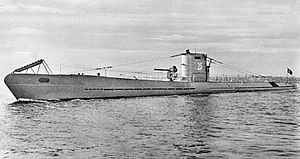Type I submarine
 U-25, a Type I U-boat. | |
| Class overview | |
|---|---|
| Builders | Deschimag, Bremen |
| Operators |  Kriegsmarine Kriegsmarine |
| Preceded by | Spanish Type E1 |
| Succeeded by |
|
| Cost | 4,500,000 ℛ︁ℳ︁ |
| In commission | 1936 – 1940 |
| Planned | 2 |
| Completed | 2 |
| Lost | 2 |
| General characteristics | |
| Displacement |
|
| Length | 72.39 m (237 ft 6 in) |
| Beam | 6.21 m (20 ft 4 in) |
| Draft | 4.30 m (14 ft 1 in) |
| Propulsion |
|
| Speed |
|
| Range |
|
| Test depth | 200 m (660 ft) |
| Complement | 4 officers, 39 enlisted |
| Armament |
|
The Type I U-boat was the first post–World War I attempt to produce an oceangoing submarine for Nazi Germany's Kriegsmarine. The type was based on the Spanish Type E-1,[1] designed by Ingenieurskantoor voor Scheepsbouw (the company also designed the Soviet S class submarine, and the Finnish Vetehinen class). Only two Type IAs were built. They were not a successful design : due to its single rudder they had a large turning circle and were not very manoeuvrable. The gravity center of the U-boat was too forward so on surface the type I had its propellers exposed when she was pitching. Whilst submerged there were problems with depth keeping and stability as air bubbles in fuel tanks wobbled back and forth. Diving was very slow : at full speed and with six tons of negative buoyancy it took forty seconds to reach ten metres depth. As a result, the type was discontinued and a new type IX class oceangoing U-boats was designed.[2]
Constructed by Deschimag in Bremen, the first Type IA was launched on 14 February 1936. The two boats produced, U-25 and U-26, were primarily used as training vessels and for propaganda purposes to fly the Nazi flag. In 1940, the boats were called into combat duty due to the shortage of available submarines. Both boats experienced short, but successful combat careers. U-25 participated in five war cruises, sinking eight enemy ships. On 3 August 1940, while on a mine laying mission near Norway, U-25 struck a mine and sank with all hands on board.[1]
U-26 carried out eight war cruises, sinking three merchant ships on its first mission laying mines. On its second war cruise it became the first U-boat during World War II to enter the Mediterranean Sea. U-26 participated in three other successful war patrols, sinking four additional merchant ships. On its eighth war cruise the boat sank three merchant ships and damaged another ship the next day. The attack on this ship led to severe depth-charging by two British warships, including HMS Gladiolus.[1] Unable to dive, U-26 was forced to surface where she was bombed by a Sunderland flying boat. The crew scuttled the submarine and were rescued by Allied warships.
List of Type I submarines
- German submarine U-25 (1936)
- German submarine U-26 (1936)
References
- ^ a b c Gröner 1991, p. 39.
- ^ Paterson 2003, p. x-xi.
Bibliography
- Gröner, Erich; Jung, Dieter; Maass, Martin (1991). German Warships 1815–1945, U-boats and Mine Warfare Vessels. Vol. 2. Translated by Thomas, Keith; Magowan, Rachel. London: Conway Maritime Press. ISBN 0-85177-593-4.
- Paterson, Lawrence (2003). Second U-Boat Flottila. Leo Cooper. ISBN 0-85052-917-4.
External links
- "U-Boat Aces.com". U-Boat Types – Type IA U-Boat. Retrieved 31 July 2006.
- Helgason, Guðmundur. "U-Boat Types – Type IA". German U-boats of World War II - Uboat.net. Retrieved 31 July 2006.










